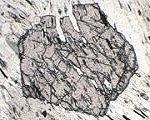Practical Aspects of Mineral Thermobarometry
Plagioclase
Structure, sites and end members
The feldspar structure consists of a three-dimensional framework of Si and Al tetrahedra, enclosing large, irregularly coordinated sites which can contain Na, Ca, and K (also Ba, Sr, Rb). The important end members are
- NaAlSi3O8 - Albite
- CaAl2Si2O8 - Anorthite
- KAlSi3O8 - K-feldspar
Metamorphic plagioclases generally contain very limited K, although in the granulite facies truly ternary Na-Ca-K feldspars may be encountered.
Stoichiometry
There are five cations per formula unit: four tetrahedra and one large cation site. Na + Ca (+ K) should sum to 1. Many feldspar analyses show a small amount of Fe, just above the detection limit. It is generally presumed to be Fe3+, substituting for Al.
The solid solution between albite and anorthite is a coupled, charge-balanced substitution CaAl for NaSi (in exchange vector notation CaAlNa-1Si-1). In metamorphic plagioclases it is usually possible to ignore the minor substitution of K, and to assume that all sites are filled. Thus, in most plagioclases there is essentially just one compositional variable, the anorthite content, and if we represent it by x the formula should be
Na1-xCaxAl1+xSi3-xO8
It is always worth checking to see if microprobe analyses of plagioclase approximately obey this relationship. If they don't, there may be a problem with
- calibration of probe standards for Si, Al, Na or Ca.
- alkali loss from the analysis spot - beam current too high.
Compositional zoning in plagioclase
Changes in plagioclase composition must involve not only exchange of Na and Ca in the large sites but also Al for Si in the tetrahedral framework. Because interdiffusion of Al and Si is a difficult process, compositional zoning is quite commonly preserved in metamorphic feldspars. As for garnets, it could represent either (or both):
- growth during a continuous reaction, with negligible lattice diffusion.
- incomplete diffusional re-equilibration of pre-existing plagioclase.
The zonation is commonly arranged concentrically in plagioclase grains. Some writers use the same convention as in igneous rocks: in normal zoning Na increases towards the rim; in reverse zoning Ca increases towards the rim. In practice, reverse zoning (Ca increase) is more common, and it may often arise as a growth zoning because Ca held in epidote, garnet or carbonates at lower grade is transferred to plagioclase in the amphibolite facies.
There are important practical consequences (and sometimes inconveniences) arising from the fact that important geobarometers depend on the mutual equilibration of plagioclase and garnet, two rather refractory phases.
This page last modified 12 October 2004
